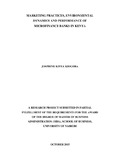| dc.description.abstract | Marketing practices are seen as essential tools for enhancing performance to most institutions. However, some of the firms that have adopted these practices have succeeded while others have failed. This study was guided by the following objectives: to determine the marketing practices used by microfinance banks in Kenya, to determine the effect of marketing practices on the performance of microfinance banks in Kenya and to establish the influence of environmental dynamics on the performance of microfinance banks in Kenya. The study used a descriptive research design. The population for this study included all the 12 microfinance banks in Kenya that are licensed under the central bank of Kenya. The study collected primary data using a semi-structured questionnaire. Out of the 12 questionnaires that were distributed for data collection only 10 questionnaires were successfully filled and returned to the researcher. This represents a response rate of 83% which was considered sufficient for making generalization of all the microfinance banks in Kenya. Data analysis was done using descriptive statistics and a regression model. The study findings conclude that market segmentation and targeting were most popularly used by microfinance banks as compared to market module and planning. The findings observed that these practices acted as essential tools for attracting new customers. Implementation of these practices enabled the bank to accommodate the changing needs of the customer and thus improved customer satisfaction. This was achieved in light of the environmental dynamics that are envisaged in the environment. The regression found that there was a statistically significant relationship between marketing practices and performance of microfinance banks in Kenya. Some of the most notable environment dynamics include; information communication technology (ICT), banking regulations and changing customer needs. These external changes influenced performance of microfinance banks according to most of the respondents. One of the limitations of this study is that the selection of the variables is not exhaustive. Specifically, the conceptualization of marketing practices might be limited and it’s arguable that marketing practices might consist of more than market segmentation, targeting, marketing planning and marketing module. This means that other additional factors could provide further insight marketing practices and performance relationship. The factors included in the current conceptual framework may not provide a clear picture of the firms’ marketing practices, external environmental factors and performance measures. Future researchers should consider replicating this study in the whole of banking industry like commercial banks and Saccos. Other sectors like manufacturing and insurance companies would also be suitable to provide comparative findings. This will give a more detailed view of the nature of the relationship identified in the study. It would be appropriate to study the relationship between market practices and performance in the whole of banking industry. The replication of this study in other countries especially in the Sub- Saharan region would demonstrate the universality and significance of the market practices and performance relationship in general. | en_US |

